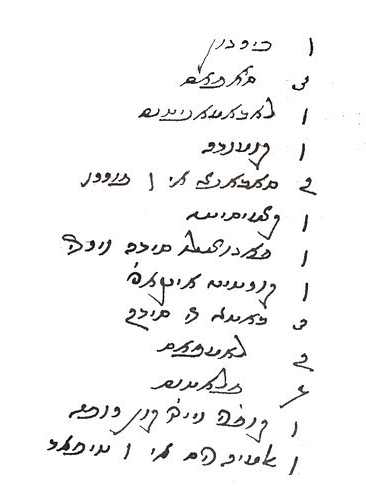Unknown Language #13
« previous post | next post »
Submitted by François Lang on behalf of his neighbor:

My first intuition / impulse was that it was some sort of Semitic script. Then, because I detected vague resemblances to Brahmi and Kharoṣṭhī, both of which may have derived from Aramaic, I started to think of the latter script. However, prompted by Oktor Skjaervo, Syriac seems more likely. See the chart here. But what Devin Stewart suggested about a Geniza document in Hebrew or Judeao-Arabic also seemed possible.
Several colleagues pointed to a cursive form of Hebrew (Alexander Vovin, Stefan Georg, James Ward, and John Mullan).
François Lang observed, "The writing looks right justified, so it's presumably written right to left. Might it be handwritten Hebrew?" He further added:
Here is more information about the document from other members of our local neighborhood ListServ:
(1) This is from RG 84, General Correspondence of the American consulate in Tangier, Morocco. The dates of the stuff is either 1912 or 1917.
(2) It is in Ladino (Judeo-Spanish) written in cursive Rashi script (a variant of the Hebrew script).
Simcha Gross suggested Ladino.
Lore Sander says, "According to the old book of Hans Jensen: (Die Schrift, p. 290) it is a cursive variety of Canaanite Script."
It's fairly obvious where we're circling around. Hopefully we've given enough ideas that someone will be able to transliterate and translate what's written on the paper copied above.
Selected readings
- "Indo-Egyptian mystery" (10/18/13) — see especially the first comment
- "Cairo Geniza"
- "Geniza" –The word genizah comes from the Hebrew triconsonantal root g-n-z, which means "to hide" or "to put away". The derived noun meant 'hiding' and later a place where one put things, and is perhaps best translated as "archive" or "repository".
- "Unknown Language #12" (7/18/20)
[Thanks to Joe Lowry and Bill Granara]
David Cameron Staples said,
August 12, 2021 @ 7:57 pm
https://en.wikipedia.org/wiki/Solitreo
Keith said,
August 13, 2021 @ 6:20 am
To my inexpert eye it definitely looks like a list, with a numeral followed by text, written from right to left. Maybe cursive estrangela Syriac?
https://en.m.wikipedia.org/wiki/Syriac_alphabet
Rodger C said,
August 13, 2021 @ 9:40 am
Surely Solitreo, and it seems to be a list enumerating "1 of A, 3 of B, 1 of C," etc. Now we need someone that can actually read Solitreo to identify the language and translate it.
Josh said,
August 13, 2021 @ 10:03 am
This doesn't feel like Solitreo exactly as it's depicted on Wikipedia. A symbol that looks like https://en.wikipedia.org/wiki/Solitreo#/media/File:Sol_samek.png is at the (left) end of a bunch of words, which makes me think it's more likely mem sofit (ם) than samech (ס). Though of course there are surely handwriting variations; I'm not disputing that it's Solitreo.
Rodger C said,
August 13, 2021 @ 3:28 pm
Josh: Isn't your observation consistent with Judeo-Spanish?
John Swindle said,
August 13, 2021 @ 9:40 pm
Seems like we should have a transliteration or a candidate transliteration by now (he says helpfully).
Brett said,
August 13, 2021 @ 11:29 pm
The most common initial letter on the list appears four times at the beginning of words. And the glyph bears a strong resemblance to the alef in Solitreo (although the loop goes the other way). The high frequency of words starting with alef suggests that the underlying language may be Hebrew, rather than Ladino or something else.
David Marjanović said,
August 14, 2021 @ 7:30 am
Why? Word-initial vowels are written as, or preceded by, alef even in Yiddish.
Lameen said,
August 15, 2021 @ 4:42 am
This does indeed look like Judeo-Spanish in some kind of cursive Hebrew. If I'm not mistaken, the 4th and 3rd from last items are:
2 lampas
4 platos
Lameen said,
August 15, 2021 @ 7:53 am
And could the third one be
1 lavamanitos?